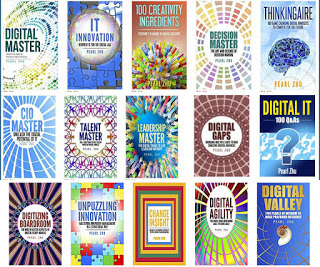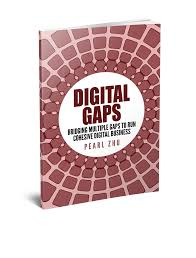Pearl Zhu's Blog, page 1232
April 30, 2017
Brainstorming The IT Role in Building Business Competency via Inquiries
 Nowadays, information permeates into every corner of the business, it is the gold mine organizations need to dig for capturing the next business growth opportunities. Technology is often the disruptive force of digital innovation, as well as the crucial component of building the business capability. Hence, Information Technology should be seen by any business as a “digital transformer.” Here are a few inquiries to clarify IT role in building business competency.
Nowadays, information permeates into every corner of the business, it is the gold mine organizations need to dig for capturing the next business growth opportunities. Technology is often the disruptive force of digital innovation, as well as the crucial component of building the business capability. Hence, Information Technology should be seen by any business as a “digital transformer.” Here are a few inquiries to clarify IT role in building business competency.
What demand does strategy create for new information technology-enabled business capability, and how will you bring that to reality? Organizations rely more and more on technology; the IT department has more and more to overcome. The goals of running IT is about leverage information to improve decision effectiveness, and apply technology to lower costs, improve operations, and increase revenue. IT needs to rethink itself as an innovative and business leading organization. It has to provide both business and technological insight into how they bring success to the company as a whole instead of being a support center. There are very few businesses today can state that IT does not play a significant role in the day to day operations or even long-term strategic positioning. Organizations need to take that into consideration when establishing strategic goals to manage their digital transformation. Forward-looking organizations declare they are in the information management business. Information comes from the analysis of the data, technology allows for the storing, retrieving, processing, manipulation, and presentation of data. Information and technology catalyze today's digital businesses. This requires a cross-functional customer-centric paradigm for managing and operating IT/technology, drive all sort of innovations, proactively pushing ideas on how to leverage technology to drive revenue growth, increase business productivity, flexibility, and agility.
What limitations are imposed on strategy by the constraints of the IT currently used by the company and in its digital ecosystem? Modern organization has its own sophistication: The silo functions, the sea of data, and the pool of talents. The board and top executive team should be informed on what benefit is being delivered by IT and aware of constraints and risks. Hence, those round table discussion should not be only centered around cost, but also on productivity improvement, business growth, talent strategy and GRC as well. They need to scrutinize which limitations are imposed on the digital strategy by the constraints of the IT and how to empower IT for driving changes and leading digital transformation. IT plays an important role in interpreting business issues into a technology solution and IT enabled business capabilities, also, leverage necessary resources to solve those problems. IT has the important role to play in both improving business competency and achieving operational excellence. Make continuous attention to technical excellence and keep IT fit through consolidation, integration, modernization, optimization, and innovation.
 What role does IT or the various functional groups play in risk management/governance in general, and in overseeing change in the organization? IT is in the unique position to oversee the underlying functions of the entire business, improve business efficiency, and connect the wide dots to enforce the business innovation. The abundance of information brings unprecedented opportunities and risks to the organization today. Unpredictability, uncertainty and the probability of surprising emergent properties increase with the complexity of the digital ecosystem. Hence, IT needs to also manage risks and practice governance discipline effectively. Understanding business as a dynamic and adaptive complex system is the starting point. IT organizations that have their own house in order and have absorbed compliance and operational risk management can move on to greater, more strategic business needs. IT is not limiting the business’s creativity, but encouraging out of the box thinking as well as systematic solutions. Those organizations that feel stifled by governance may not have matured beyond operational risk and control. Controls feel stifling not because they are trying to be innovative, rather that they are undisciplined. These GRC effort shouldn’t stifle innovation, rather, effective GRC disciplines have built the right mechanism to harness innovation via framing the right problems as well as setting the right prioritization, incorporated a process for change and innovation. By implementing effective GRC program, corporations can deliver immediate benefits to the entire organization.The role of IT today for many organizations is a business solutionary and the builder of digital competency. IT leaders are invited to the big table for contributing to strategy making, IT staffs are encouraged to think out of the box, and discovering the better way to do thing. Still, IT is the means to the end, the real goal for running a high-performance IT organization is to improve the business effectiveness, efficiency, agility, and maturity.
What role does IT or the various functional groups play in risk management/governance in general, and in overseeing change in the organization? IT is in the unique position to oversee the underlying functions of the entire business, improve business efficiency, and connect the wide dots to enforce the business innovation. The abundance of information brings unprecedented opportunities and risks to the organization today. Unpredictability, uncertainty and the probability of surprising emergent properties increase with the complexity of the digital ecosystem. Hence, IT needs to also manage risks and practice governance discipline effectively. Understanding business as a dynamic and adaptive complex system is the starting point. IT organizations that have their own house in order and have absorbed compliance and operational risk management can move on to greater, more strategic business needs. IT is not limiting the business’s creativity, but encouraging out of the box thinking as well as systematic solutions. Those organizations that feel stifled by governance may not have matured beyond operational risk and control. Controls feel stifling not because they are trying to be innovative, rather that they are undisciplined. These GRC effort shouldn’t stifle innovation, rather, effective GRC disciplines have built the right mechanism to harness innovation via framing the right problems as well as setting the right prioritization, incorporated a process for change and innovation. By implementing effective GRC program, corporations can deliver immediate benefits to the entire organization.The role of IT today for many organizations is a business solutionary and the builder of digital competency. IT leaders are invited to the big table for contributing to strategy making, IT staffs are encouraged to think out of the box, and discovering the better way to do thing. Still, IT is the means to the end, the real goal for running a high-performance IT organization is to improve the business effectiveness, efficiency, agility, and maturity.Follow us at: @Pearl_Zhu
Published on April 30, 2017 22:52
April 29, 2017
The Popular Quotes Collection XIII of “Digital Master” Book Series
High mature digital organizations stretch out in every business dimension.
 “Digital Master” is the series of guidebooks (15+ books) with five pillars to perceive the multifaceted impact digital is making to the business and our society, help forward-thinking organizations navigate through the digital journey in a systematic way, and avoid “rogue digital.” Here is the set of popular quotes for conveying the digital vision and sharing the unique insight about the digital transformation.
“Digital Master” is the series of guidebooks (15+ books) with five pillars to perceive the multifaceted impact digital is making to the business and our society, help forward-thinking organizations navigate through the digital journey in a systematic way, and avoid “rogue digital.” Here is the set of popular quotes for conveying the digital vision and sharing the unique insight about the digital transformation.
 Digital Gaps: Bridging Multiple Gaps to Run Cohesive Digital Business
Digital Gaps: Bridging Multiple Gaps to Run Cohesive Digital Business
“Today’s digital organizations simply just can’t stand still. Bridging the 'gap of opportunity' between where you are and want to become is a welcomed challenge.” ― Pearl Zhu, Digital Gaps: Bridging Multiple Gaps to Run Cohesive Digital Business
“Bridging innovation gaps is a strategic imperative for business execution.” ― Pearl Zhu, Digital Gaps: Bridging Multiple Gaps to Run Cohesive Digital Business
“Learning becomes the knowledge builder and we can define learning through the information it absorbs and the capability it builds.” ― Pearl Zhu, Digital Gaps: Bridging Multiple Gaps to Run Cohesive Digital Business
“We still live in the era in which information is rich and insight is poor.”― Pearl Zhu, Digital Gaps: Bridging Multiple Gaps to Run Cohesive Digital Business
“In the real, physical world or business world, most relationships are nonlinear.” ― Pearl Zhu, Digital Gaps: Bridging Multiple Gaps to Run Cohesive Digital Business
 Decision Master: The Art and Science of Decision Making by Pearl Zhu
Decision Master: The Art and Science of Decision Making by Pearl Zhu
“No decision in the world outlives the time, place, and person’s constituents on the basis of which it was made.” ― Pearl Zhu, Decision Master: The Art and Science of Decision Making
“It is often said that a wrong decision taken at the right time is better than a right decision taken at the wrong time.” ― Pearl Zhu, Decision Master: The Art and Science of Decision Making
“Decision makers with emotional excellence have the ability to dispassionately examine alternatives via fact finding, analysis, structured planning, objective evaluations, and comparison.” ― Pearl Zhu, Decision Master: The Art and Science of Decision Making
“High EQ decision makers can leverage multifaceted thought processes in making sound judgments and improving the overall decision-making maturity.” ― Pearl Zhu, Decision Master: The Art and Science of Decision Making
“Decision making is an art only until the person understands the science.” ― Pearl Zhu, Decision Master: The Art and Science of Decision Making
 100 Creativity Ingredients: Everyone’s Playbook to Unlock Creativity by Pearl ZhuBeing optimistic is the view looking for the best, it comes with the “never give up” attitude. ― Pearl Zhu, 100 Creativity Ingredients: Everyone’s Playbook to Unlock Creativity by Pearl Zhu
100 Creativity Ingredients: Everyone’s Playbook to Unlock Creativity by Pearl ZhuBeing optimistic is the view looking for the best, it comes with the “never give up” attitude. ― Pearl Zhu, 100 Creativity Ingredients: Everyone’s Playbook to Unlock Creativity by Pearl Zhu
Innovations succeed when failure is seen as a learning step to great success.-100 Creativity Ingredients: Everyone’s Playbook to Unlock Creativity by Pearl Zhu
Dissatisfaction with status quo is the psychology behind creative disruptions. -100 Creativity Ingredients: Everyone’s Playbook to Unlock Creativity by Pearl Zhu
It’s probably better and more accessible to measure change readiness rather than change progress.-100 Creativity Ingredients: Everyone’s Playbook to Unlock Creativity by Pearl Zhu
Being “misfit” with advanced thinking and forward-thinking influence is a digital fit. -100 Creativity Ingredients: Everyone’s Playbook to Unlock Creativity by Pearl Zhu
Follow us at: @Pearl_Zhu
 “Digital Master” is the series of guidebooks (15+ books) with five pillars to perceive the multifaceted impact digital is making to the business and our society, help forward-thinking organizations navigate through the digital journey in a systematic way, and avoid “rogue digital.” Here is the set of popular quotes for conveying the digital vision and sharing the unique insight about the digital transformation.
“Digital Master” is the series of guidebooks (15+ books) with five pillars to perceive the multifaceted impact digital is making to the business and our society, help forward-thinking organizations navigate through the digital journey in a systematic way, and avoid “rogue digital.” Here is the set of popular quotes for conveying the digital vision and sharing the unique insight about the digital transformation. Digital Gaps: Bridging Multiple Gaps to Run Cohesive Digital Business
Digital Gaps: Bridging Multiple Gaps to Run Cohesive Digital Business
“Today’s digital organizations simply just can’t stand still. Bridging the 'gap of opportunity' between where you are and want to become is a welcomed challenge.” ― Pearl Zhu, Digital Gaps: Bridging Multiple Gaps to Run Cohesive Digital Business
“Bridging innovation gaps is a strategic imperative for business execution.” ― Pearl Zhu, Digital Gaps: Bridging Multiple Gaps to Run Cohesive Digital Business
“Learning becomes the knowledge builder and we can define learning through the information it absorbs and the capability it builds.” ― Pearl Zhu, Digital Gaps: Bridging Multiple Gaps to Run Cohesive Digital Business
“We still live in the era in which information is rich and insight is poor.”― Pearl Zhu, Digital Gaps: Bridging Multiple Gaps to Run Cohesive Digital Business
“In the real, physical world or business world, most relationships are nonlinear.” ― Pearl Zhu, Digital Gaps: Bridging Multiple Gaps to Run Cohesive Digital Business
 Decision Master: The Art and Science of Decision Making by Pearl Zhu
Decision Master: The Art and Science of Decision Making by Pearl Zhu
“No decision in the world outlives the time, place, and person’s constituents on the basis of which it was made.” ― Pearl Zhu, Decision Master: The Art and Science of Decision Making
“It is often said that a wrong decision taken at the right time is better than a right decision taken at the wrong time.” ― Pearl Zhu, Decision Master: The Art and Science of Decision Making
“Decision makers with emotional excellence have the ability to dispassionately examine alternatives via fact finding, analysis, structured planning, objective evaluations, and comparison.” ― Pearl Zhu, Decision Master: The Art and Science of Decision Making
“High EQ decision makers can leverage multifaceted thought processes in making sound judgments and improving the overall decision-making maturity.” ― Pearl Zhu, Decision Master: The Art and Science of Decision Making
“Decision making is an art only until the person understands the science.” ― Pearl Zhu, Decision Master: The Art and Science of Decision Making
 100 Creativity Ingredients: Everyone’s Playbook to Unlock Creativity by Pearl ZhuBeing optimistic is the view looking for the best, it comes with the “never give up” attitude. ― Pearl Zhu, 100 Creativity Ingredients: Everyone’s Playbook to Unlock Creativity by Pearl Zhu
100 Creativity Ingredients: Everyone’s Playbook to Unlock Creativity by Pearl ZhuBeing optimistic is the view looking for the best, it comes with the “never give up” attitude. ― Pearl Zhu, 100 Creativity Ingredients: Everyone’s Playbook to Unlock Creativity by Pearl Zhu
Innovations succeed when failure is seen as a learning step to great success.-100 Creativity Ingredients: Everyone’s Playbook to Unlock Creativity by Pearl Zhu
Dissatisfaction with status quo is the psychology behind creative disruptions. -100 Creativity Ingredients: Everyone’s Playbook to Unlock Creativity by Pearl Zhu
It’s probably better and more accessible to measure change readiness rather than change progress.-100 Creativity Ingredients: Everyone’s Playbook to Unlock Creativity by Pearl Zhu
Being “misfit” with advanced thinking and forward-thinking influence is a digital fit. -100 Creativity Ingredients: Everyone’s Playbook to Unlock Creativity by Pearl Zhu
Follow us at: @Pearl_Zhu
Published on April 29, 2017 23:15
How to Set Performance Indicators to Measure Return on Digital Transformation
 Change is inevitable, and the speed of change is increasing. The digital transformation is now spreading rapidly to enable organizations of all shapes and sizes to reinvent themselves, but it is the thorny journey with many bumps and curves on the way. How do you measure return on digital transformation in order to make the timely adjustment and improve its success rate? A well-defined set of measurement for digital transformation should contain a good mix of outcome measures or the long-term strategic value along with performance drivers to track the progress in the short term (operational measures). The performance indicators for the digital transformation could include:
Change is inevitable, and the speed of change is increasing. The digital transformation is now spreading rapidly to enable organizations of all shapes and sizes to reinvent themselves, but it is the thorny journey with many bumps and curves on the way. How do you measure return on digital transformation in order to make the timely adjustment and improve its success rate? A well-defined set of measurement for digital transformation should contain a good mix of outcome measures or the long-term strategic value along with performance drivers to track the progress in the short term (operational measures). The performance indicators for the digital transformation could include:
Return on strategy execution capability and capacity: Digital transformation is now affecting all aspects of business operations from innovation within and around business ecosystem, to customer engagement, to business models and processes. Hence, the ROI performance management should take into account both financial and non-financial measures, assessing internal improvements, past outcomes and ongoing requirements as indications of future performance. In this regard, a Balanced scorecard offers a way for a corporation to gain a wider perspective on its strategic decisions by considering the impact on finances, customers, internal processes and employee satisfaction. In spite of capturing multiple business perspectives, the balanced scorecard must still retain a strong emphasis on financial outcomes. A well-defined scorecard should contain a good mix of outcome measures (or long-term strategic value) along with performance drivers to track the progress in the short term (operational value). If the measurement result shows that the strategy is not moving forward as desired, an organization has a cleaner structure to traverse in an attempt to identify the root cause and take mitigating actions.
Return on Innovation: Innovation is the core business capability of digital organizations. Hence, it’s important to set guidelines for developing a customized suite of innovation metrics. Select the few (3-5) KPIs, to keep the measures simple and understandable. Some choose innovation process KPIs, process KPIs could link to the digital strategy management performance, to make the progress on the percentage of projects in the total innovation portfolio which contained a major part of external innovation. The innovation metrics in the context of business impact include such as % of revenue from new products/services introduced. You could also change the variables and create something like % of the profit from new ideas implemented. The goal for the innovation measurement is to create new revenue and drive early success to create a positive spiral. Measure failures as well. Some say each successful innovation needs, at least, nine failures. If the organization allows these reasonable failures, not repetitive mistakes, it will be successful in innovation! You choose the right set of KPIs by deciding which are seen as critical to making the trackable progress in order to deliver more innovations. The fewer the better, but they have to be credible and relevant also in the eyes of the stakeholders.
Return on customer-centricity: Forward-looking organizations strive to become customer-centric digital businesses. Thus, it is important to set metrics to clarify plan of customer-centric process implementation, control and measures, such as: How many processes or customer touch points are included, how many staff people are involved, what are company internal performance versus Customer Experience (their expectations/ satisfaction)? Is it possible to measure it in each Touch Point? What activities can be done to improve processes to save time and money? Net Promoter Score (NPS) is the closest thing for leadership teams who want to see a link between customer experience and strategy management. NPS, if properly executed, can deliver valuable input. NPS also measures success in terms of Customer Equity. Customer Equity looks at the lifetime value of customers, the cost to attract new customers and the cost to retain customers over a given outlook period.
Return on Risk management: The increasing speed of changes and overwhelming growth of information bring both opportunities and risks to businesses. Organizations that are able to flex the risk-reward balance predominantly through being risk aware more effectively can achieve the digital strategy and build the competitive advantage because they are better placed to walk away from high-risk situations or possibly transfer risk to lower cost. The point is that they are more risk conscious and, therefore, the are able to make more informed decisions. The bottom line of return on investment (ROI) should be achieved and can be measured if there is a marked improvement in reducing/streamlining the processes, and managing the risks to an acceptable level by the enterprise management oversight. Often the real return on investment doesn't occur until you reach the "pro-active" features, which reduce cost and increased impact on the enterprise. those would be some of the areas being considered successful. The most commonly used dimensions to measure risk management consist of -• Strategic – risk & compliance posture, risk enabled decision-making, etc. • Financial - Reduced cost of risk & compliance, improved bottom-line, value to stakeholders etc.• Operational – operational efficiency, program visibility, reduced turn-around-time,• Regulatory – reduced audit failures, predictive compliance i.e. ability for early diagnose of non-compliance etc.
Return on employee engagement: Digital is the era of people. Generally speaking, there are two types of measurement of employee engagement: the first type of measurement of creativity in the workplace is through the outcomes of productivity or creativity. What value have those new things designed and implemented (products, services, processes, business models) brought to customers or users? The second type of assessment is through the performance drivers, the elements that enhance an organization's execution capacity. The metrics for talent management improvement include engagement, cost control, return on incentives, recruiting efficiency, speed in revising performance objectives, clarity of organizational structure, depth of backups in succession plans, the culture of creativity measurement. By tracking these measures, you can focus on where targets are not being met that support planned revenue and profit levels, and what actions might be taken to improve at the individual, functional, and corporate levels.
 Return on digital maturity and measurement: Digital transformation extends to every direction of the business management. Which management metrics should you apply to measure organizational overall health and maturity? Who and what tools are being applied to measure the business performance? Historically, performance measurement systems for most businesses have been financing driven. However, in many business situations, financial indicators only cover part of the story. The effective measurements selected should be part of a link of cause-and- effect relationships, ending in financial objectives that ultimately affect the growth and long-term perspective of the organization. A KPI must last while the process it is measuring lasts. It must be constantly reviewed and improved. Outcome-related KPIs are as relevant as, even more relevant than process-related KPIs, in order to measure the end to end business performance effectively.
Return on digital maturity and measurement: Digital transformation extends to every direction of the business management. Which management metrics should you apply to measure organizational overall health and maturity? Who and what tools are being applied to measure the business performance? Historically, performance measurement systems for most businesses have been financing driven. However, in many business situations, financial indicators only cover part of the story. The effective measurements selected should be part of a link of cause-and- effect relationships, ending in financial objectives that ultimately affect the growth and long-term perspective of the organization. A KPI must last while the process it is measuring lasts. It must be constantly reviewed and improved. Outcome-related KPIs are as relevant as, even more relevant than process-related KPIs, in order to measure the end to end business performance effectively.
Digital transformation is a journey. Well defining the right set of metrics will never be an easy job, but always keep in mind of the simplicity principles, and do not confuse the means with the end. Measure the right things, and measure them right, for encouraging positive behaviors, breaking down silo thinking, leveraging trade-offs, to ensure the business as a whole achieving the optimal business result and manage a seamless digital transformation.
Follow us at: @Pearl_Zhu
Published on April 29, 2017 23:05
April 28, 2017
What Should the Board of Director’s Skills Matrix Include?
 The board of director plays a significant role in overseeing organizational strategy, setting policies, practicing governance and exemplifying leadership disciplines. The contemporary corporate boards need to focus on both performance and compliance, monitoring business performance and improving management effectiveness. Due to the “VUCA” digital new normal, the directorship in any organization must have the ability to inspire, guide, and motivate. What should the board of director’s skill matrix include to improve the directorship maturity individually or collectively?Leadership Competency: The effective functioning of a board depends on a number of factors, including the mix of knowledge and experience among the directors, Diversity in thought processes, experiences, industries, and situations are more important as a team. Leadership is all about future and change. Strategic thinking, governance, auditing, risk management, regulatory issues, mentoring and coaching, openness to communication are some of the areas of director competencies though it may be contextual. They should have abilities to probe issues in depth, disagree without being disagreeable, mentoring and be mentored, understanding risks, a functional skill, and promoting teamwork. Vision is an integral part of the directorial role, BoDs as the digital visionary can make a better influence on guiding the organization toward the right decision and bring profound insight in transforming the business up to the next level of business maturity. Critical thinking and strategic thinking capability: The contemporary board plays a crucial role in overseeing business strategy. The strategy is definitely a different beast nowadays. With increasing speed of changes, many organizations are inundated with tactical tasks and daily operational duties, they don’t spend enough time on scrutinizing the long term strategy and identify disastrous blind spots in order to make a smooth business transformation. Hence, critical thinking and strategic thinking capability are important for BoDs as the business critic who can provide excellent feedback which gives the top management accurate information to improve; great questions to contemplate, and keen insight to gain the in-depth understanding of the digital business ecosystem. "Group-think" and lack of courage to ask the tough, strategic questions is the chief weakness on Boards today. The Board has to have a good understanding of the organization’s strategic direction and its strategic alternatives. The digital BoDs need to present strategic wisdom to pinpoint pitfalls in strategy management and keep track of strategy-execution continuum. Decision effectiveness: Governance disciple enables better decisions. Governance is a sophisticated process that if well executed, will lead to better decisions. It will allow not only to protect the existing value but also to create new value for its shareholders. It is important to emphasize that governance is fundamentally about having a systematic approach to making decisions within the corporate entity. The boards play crucial roles in oversight of the business assessment, gauging conditions and choices; oversight of appropriation, matching priorities and resources; oversight of accountability, scoring activity and net results. Governance is like the steer-wheel to ensure organizations running in the right direction and head to the destination. Good governance must create excellent performance, especially for the long-term business growth.In a world of rapid changes, directors are required to exercise leadership influence and improve decision effectiveness over volatility, manage uncertainty, simplify complexity, and resolve ambiguity in the 21st-century digital environment.
The board of director plays a significant role in overseeing organizational strategy, setting policies, practicing governance and exemplifying leadership disciplines. The contemporary corporate boards need to focus on both performance and compliance, monitoring business performance and improving management effectiveness. Due to the “VUCA” digital new normal, the directorship in any organization must have the ability to inspire, guide, and motivate. What should the board of director’s skill matrix include to improve the directorship maturity individually or collectively?Leadership Competency: The effective functioning of a board depends on a number of factors, including the mix of knowledge and experience among the directors, Diversity in thought processes, experiences, industries, and situations are more important as a team. Leadership is all about future and change. Strategic thinking, governance, auditing, risk management, regulatory issues, mentoring and coaching, openness to communication are some of the areas of director competencies though it may be contextual. They should have abilities to probe issues in depth, disagree without being disagreeable, mentoring and be mentored, understanding risks, a functional skill, and promoting teamwork. Vision is an integral part of the directorial role, BoDs as the digital visionary can make a better influence on guiding the organization toward the right decision and bring profound insight in transforming the business up to the next level of business maturity. Critical thinking and strategic thinking capability: The contemporary board plays a crucial role in overseeing business strategy. The strategy is definitely a different beast nowadays. With increasing speed of changes, many organizations are inundated with tactical tasks and daily operational duties, they don’t spend enough time on scrutinizing the long term strategy and identify disastrous blind spots in order to make a smooth business transformation. Hence, critical thinking and strategic thinking capability are important for BoDs as the business critic who can provide excellent feedback which gives the top management accurate information to improve; great questions to contemplate, and keen insight to gain the in-depth understanding of the digital business ecosystem. "Group-think" and lack of courage to ask the tough, strategic questions is the chief weakness on Boards today. The Board has to have a good understanding of the organization’s strategic direction and its strategic alternatives. The digital BoDs need to present strategic wisdom to pinpoint pitfalls in strategy management and keep track of strategy-execution continuum. Decision effectiveness: Governance disciple enables better decisions. Governance is a sophisticated process that if well executed, will lead to better decisions. It will allow not only to protect the existing value but also to create new value for its shareholders. It is important to emphasize that governance is fundamentally about having a systematic approach to making decisions within the corporate entity. The boards play crucial roles in oversight of the business assessment, gauging conditions and choices; oversight of appropriation, matching priorities and resources; oversight of accountability, scoring activity and net results. Governance is like the steer-wheel to ensure organizations running in the right direction and head to the destination. Good governance must create excellent performance, especially for the long-term business growth.In a world of rapid changes, directors are required to exercise leadership influence and improve decision effectiveness over volatility, manage uncertainty, simplify complexity, and resolve ambiguity in the 21st-century digital environment.
 Changeability: Change capability is a strategic skill on leadership qualities.While there are many components of leadership, one of the most important ones is the ability to adapt, model and influence change. We live in a world where change is the norm and if we don't embrace it, accept it, roll with it or make it happen, we're not going to be successful. Nowadays, the speed of change is increasing and digital transformation is an inevitable journey, BoDs should set the tones for change and proactively drive change to ensure the organization is moving in the right direction with an accelerated speed. The leadership team such as board must push the business’s change agenda, but pull the resources to achieve it. It also makes it possible for everyone to be on the same page speaking the same language and fosters an atmosphere of accountability.The collective skills and capabilities of BoDs make a significant impact on both the business’s survival and thriving. Boards are getting better as the awareness grows of how important board composition is in order to lead in today’s digital dynamic. The more a board represents or mirrors its stakeholders, the better served will be the organization. It’s all about leadership from the top which sets the leadership tone and steers the business toward the right direction to achieve the long-term prosperity.
Changeability: Change capability is a strategic skill on leadership qualities.While there are many components of leadership, one of the most important ones is the ability to adapt, model and influence change. We live in a world where change is the norm and if we don't embrace it, accept it, roll with it or make it happen, we're not going to be successful. Nowadays, the speed of change is increasing and digital transformation is an inevitable journey, BoDs should set the tones for change and proactively drive change to ensure the organization is moving in the right direction with an accelerated speed. The leadership team such as board must push the business’s change agenda, but pull the resources to achieve it. It also makes it possible for everyone to be on the same page speaking the same language and fosters an atmosphere of accountability.The collective skills and capabilities of BoDs make a significant impact on both the business’s survival and thriving. Boards are getting better as the awareness grows of how important board composition is in order to lead in today’s digital dynamic. The more a board represents or mirrors its stakeholders, the better served will be the organization. It’s all about leadership from the top which sets the leadership tone and steers the business toward the right direction to achieve the long-term prosperity.Follow us at: @Pearl_Zhu
Published on April 28, 2017 23:10
The “Upward” Digital CIOs: Can you Move Up from “Working in IT” to “Working on IT”?
 The traditional role of CIOs is to manage information, IT systems, and cost, often within the IT as the support function. Thus, IT is often perceived as a cost center to “keep the lights on” only. Many of today’s C-suites are unaware of what is technologically possible now or in the future, and how to leverage IT to unleash the full potential of the digital organization. Hence, to improve IT leadership effectiveness and maturity, today’s digital CIOs should move “upward,” from working within IT to focus on transactional business activities and improve the bottom line efficiency to working on IT and expand its impact across the business boundary and lead the digital transformation of the company proactively.
The traditional role of CIOs is to manage information, IT systems, and cost, often within the IT as the support function. Thus, IT is often perceived as a cost center to “keep the lights on” only. Many of today’s C-suites are unaware of what is technologically possible now or in the future, and how to leverage IT to unleash the full potential of the digital organization. Hence, to improve IT leadership effectiveness and maturity, today’s digital CIOs should move “upward,” from working within IT to focus on transactional business activities and improve the bottom line efficiency to working on IT and expand its impact across the business boundary and lead the digital transformation of the company proactively.
The CIO’s role should shift from a tactical IT manager to an outlier digital leader: Traditional IT managers often get stuck in the “comfort zone,” to run IT as a silo function to keep the lights on. Outlier CIOs need to know how to play a bridge between what the business understands and what technology understands. They work on the IT, move across functions seamlessly, rather than just within IT. They would then make sure the two worlds meet to ensure an optimal performing business. Outlier CIOs are the one who can step out of a conventional IT thinking box, or linear patterns. Therefore, they could see things further or deeper. Outlier CIOs have the growth mind, interdisciplinary knowledge, creativity, and their imagination are not constrained by the technical knowledge. They can convey a clear technological vision, and lead change confidently and effortlessly. Being outlier CIOs doesn’t mean they couldn't be the handy tactical manager when needed. It means that they are both strategic and creative thinker who dare to ask a deep “WHY” - to diagnose the root cause of problems but also ask the optimistic “Why NOT?" -The refusal to be bound by constraints and limitations and a pursuit of possibilities and discover the growth opportunities for the business. Because digital transformation means you have to make the radical changes, that can’t be done by the existing mere management model, you have to adopt a fresh thinking and run IT from outside-in perspectives.
Working on IT also means that IT should shine in both roles as the business enabler and driver: Due to the increasing pace of changes and exponential growth of information, the biggest IT challenge is the pace at which the IT executive's responsibility for business operations, efficiency, effectiveness, and continuity is outpacing his or her authority to make those areas a success. The further concern is whether doing business-IT alignment is mature enough for IT to become a business’s strategic partner. What should be focused on is the integration of IT into the business decisions and processes. Information Management is no longer just IT’s business, but the business of the entire company. The CIO needs to understand the needs of the different business units, and take those needs and translate them into an IT investment to support that vision. An opportunity for the CIO to add a lot of value in the C-Suite is helping C-Level leaders understand the possibilities of how new technologies can enhance the creation or improvement of products and services while balancing the technical and business risks, the investment needed, timing, etc IT needs to be the spinal cord for the organization, integrating various departments, to simplify and optimize processes across functional boundaries, and often across the entire enterprise.
 IT leaders need to work across multiple functional boxes for connecting dots to spur innovation: Simply working within IT is not sufficient to transform IT leader from Chief Information Officer to Chief Innovation Officer. There’s a lot of opportunities to clarify the role of IT in innovation. CIOs can perhaps work within IT to innovate its function, but more importantly, they have to leverage IT for build the enterprise innovation capabilities. Companies are recognizing that IT is roughly coupled to the business strategy as an innovation engine, and it is a very good sign about how the companies will deliver value. The CIO is in a unique position to align process, technology, and people, from generating ideas on applying technology and data assets to drive business value, CIOs need to talk about commercial outcomes, not technical throughput. They should have team leaders partner with and even embed themselves in business functions so they can ensure IT folk understanding the commercial end point of their work. So the oversight is needed in managing the full innovation lifecycle.
IT leaders need to work across multiple functional boxes for connecting dots to spur innovation: Simply working within IT is not sufficient to transform IT leader from Chief Information Officer to Chief Innovation Officer. There’s a lot of opportunities to clarify the role of IT in innovation. CIOs can perhaps work within IT to innovate its function, but more importantly, they have to leverage IT for build the enterprise innovation capabilities. Companies are recognizing that IT is roughly coupled to the business strategy as an innovation engine, and it is a very good sign about how the companies will deliver value. The CIO is in a unique position to align process, technology, and people, from generating ideas on applying technology and data assets to drive business value, CIOs need to talk about commercial outcomes, not technical throughput. They should have team leaders partner with and even embed themselves in business functions so they can ensure IT folk understanding the commercial end point of their work. So the oversight is needed in managing the full innovation lifecycle.
An upward digital CIO has to focus on guiding the company through the digital transformation by working cross-functionally. At the very least, IT must be a business partner within the organization. The organization has built highly interactive teams with representatives from each line of business focused on finding an innovative new way to improve the business performance. IT continues to reach a higher level of digital maturity, from alignment to integration, engagement, and optimization.
Follow us at: @Pearl_Zhu
Published on April 28, 2017 23:05
April 27, 2017
The Weekly Insight of the “Future of CIO” 4/28/ 2017
 The “Future of CIO” Blog has reached 1.8 million pageviews with 3700+ blog posting in 59+ different categories of leadership, management, strategy, digitalization, change/talent, etc. The content richness is not for its own sake, but to convey the vision and share the wisdom. Here is the weekly insight about digital leadership, IT Management, and Talent Management.
The “Future of CIO” Blog has reached 1.8 million pageviews with 3700+ blog posting in 59+ different categories of leadership, management, strategy, digitalization, change/talent, etc. The content richness is not for its own sake, but to convey the vision and share the wisdom. Here is the weekly insight about digital leadership, IT Management, and Talent Management.
The Weekly Insight of the “Future of CIO” 4/28/2017CIOs as: “Chief Insight Officer”: What are the Digital Aims of the Organizations: Digital makes a profound impact from the specific function to the business as a whole. Transformation is a leapfrogging change when the final result is not fully defined at the beginning of it and with the expectation to reach the next level of progression. IT plays a crucial role in digital transformation because it is in the unique position to oversee the underlying business processes and functions. Hence, in order to clarify the digital aim and lead change more effectively, CIOs as “Chief Insight Officer” should continue asking: “Why do you need to change?” “What is your digital aims of the organization?” “Who are your change agents?” “Have you reached the inflection point of change yet?” And“How to get the destination with faster speed?”
The New Book “Digital IT - 100 Q&As” Quote Collection III: The purpose of “Digital IT-100 Q&As “ is to summarize 100+ classic and emergent digital debates about digital IT leadership and management, brainstorm how to run a holistic digital business from multidimensional lens, share digital holism and strategic insight, keep IT digital fit, deal with both IT management dilemmas and innovation paradoxes effortlessly, guide today’s digital leaders and professionals to learn the valuable lessons across industrial and geographical boundaries, develop the best and next digital practices to tailor their needs, set the right priorities to achieve high performance, and build a solid digital brand, with the goal to accelerate digital transformation.
Digital Boards with Vision Inquiries The contemporary corporate board as the top leadership team plays a directorial role in envisioning the future of the business and overseeing corporate strategy. Because leadership is about future and change. Vision is not the “Nice to have,” but “Must have” quality for top leaders in order to direct the organization toward the uncharted water or blurred territories in today’s “VUCA” digital dynamic. Vision is basically a qualitative statement defining the "perception" of the organization, and the effective board provides the guidance about what core to preserve and what future to stimulate progress toward. Here are a few vision inquiries of digital boards.
 What are the Biggest Barriers to Digital Effectiveness in Organizations? Digital transformation is the rough road with all bumps and curves on the way. There are a number of challenges common in transformation programs, such as having a clear vision, getting the right strategies, execution, a forward-thinking leader to convey the transformational vision, and a broader view of customer demand, etc. More specifically, what are the biggest barriers to digital effectiveness and how to overcome them for improving the digital business performance and maturity.
What are the Biggest Barriers to Digital Effectiveness in Organizations? Digital transformation is the rough road with all bumps and curves on the way. There are a number of challenges common in transformation programs, such as having a clear vision, getting the right strategies, execution, a forward-thinking leader to convey the transformational vision, and a broader view of customer demand, etc. More specifically, what are the biggest barriers to digital effectiveness and how to overcome them for improving the digital business performance and maturity.
The Multifaceted Creativity Creativity is the most needed skill in the 21st century, because digital is the era of innovation. Creativity is both innate and a skill. Developing creativity requires both internal motivation and self-awareness. Being original and being yourself is the first step, breaking down the convention thinking box, and practicing out-of-the-box thinking are the mental activities to stimulate creativity as well. Here is the further understanding about the multifaceted creativity. ?
Blogging is not about writing, but about thinking and innovating the new ideas; it’s not just about WHAT to say, but about WHY to say, and HOW to say it. It reflects the color and shade of your thought patterns, and it indicates the peaks and curves of your thinking waves. Unlike pure entertainment, quality and professional content takes time for digesting, contemplation and engaging, and therefore, it takes the time to attract the "hungry minds" and the "deep souls." It’s the journey to amplify diverse voices and deepen digital footprints, and it's the way to harness your innovative spirit.
Follow us at: @Pearl_Zhu
Published on April 27, 2017 23:00
The New Book “Digital IT - 100 Q&As” Quote Collection V
 The purpose of “Digital IT-100 Q&As “ is to summarize 100+ classic and emergent digital debates about digital IT leadership and management, brainstorm how to run a holistic digital business from multidimensional lens, share digital holism and strategic insight, keep IT digital fit, deal with both IT management dilemmas and innovation paradoxes effortlessly, guide today’s digital leaders and professionals to learn the valuable lessons across industrial and geographical boundaries, develop the best and next digital practices to tailor their needs, set the right priorities to achieve high performance, and build a solid digital brand, with the goal to accelerate digital transformation.
The purpose of “Digital IT-100 Q&As “ is to summarize 100+ classic and emergent digital debates about digital IT leadership and management, brainstorm how to run a holistic digital business from multidimensional lens, share digital holism and strategic insight, keep IT digital fit, deal with both IT management dilemmas and innovation paradoxes effortlessly, guide today’s digital leaders and professionals to learn the valuable lessons across industrial and geographical boundaries, develop the best and next digital practices to tailor their needs, set the right priorities to achieve high performance, and build a solid digital brand, with the goal to accelerate digital transformation.101 The “Art of Possible” can only be achieved through visionary IT leadership, as well as the art and science of modern IT management.102 Communication, collaboration, and creativity are the keys to run IT as a better business partner.103 The best way to promote IT is to communicate proactively with critical thinking and creative thinking.104 High-mature IT has a high trustful business-IT relationship, it is highly responsive to changes and proactively manages innovation.105 The best or next digital talent management practices should encourage innovation, inspire learning, take a structural approach to make the digital transformation.106 Hire mindset and capabilities, train for specific skills.107 Don’t be afraid to look above, below, and outside of the talent pools that you are see, to explore the alternative digital talent pipeline.108 The nonlinear capabilities and unique competency-based on the cohesive set of capabilities will give the digital professionals the advantage to compete for the future.109 Digital business becomes always on, borderless, more hyper-connected, and interdependent than ever.110 Figuring out what employees are not saying might be the start point to greater retention and a more engaged workforce.
 111 The business leaders must work with the right mindset to create an inclusive organization with every dip in the business life cycle.112 Workforce performance improvement must take the long-term view and require a core DNA transplant.113 The effective vehicles for retaining the top talent are effective leadership, agile mindset, the culture of learning, robust processes, and cool technology tools.114 A high-mature digital organization is shifting from “pushing” stuff to the digital channel into “pulling” resources up for problem-solving.115 You should always leverage performance and potential, look at the overall success of the company for the long run.
111 The business leaders must work with the right mindset to create an inclusive organization with every dip in the business life cycle.112 Workforce performance improvement must take the long-term view and require a core DNA transplant.113 The effective vehicles for retaining the top talent are effective leadership, agile mindset, the culture of learning, robust processes, and cool technology tools.114 A high-mature digital organization is shifting from “pushing” stuff to the digital channel into “pulling” resources up for problem-solving.115 You should always leverage performance and potential, look at the overall success of the company for the long run. Follow us at: @Pearl_Zhu
Published on April 27, 2017 22:56
Digital Organizational Design vs. Business Changeability
 Digital makes a significant impact on every aspect of the business both horizontally and vertically. The very characteristics of digital is the increasing speed of change and hyperconnectivity. Forward-looking organizations leverage the latest technologies to fine tune the organizational structure and improve the business changeability. Organization design is the vehicle through which the business strategy is executed and defines the business environment in which the digital organization can reduce the change friction, improve the business adaptability, and unleash its full potential.
Digital makes a significant impact on every aspect of the business both horizontally and vertically. The very characteristics of digital is the increasing speed of change and hyperconnectivity. Forward-looking organizations leverage the latest technologies to fine tune the organizational structure and improve the business changeability. Organization design is the vehicle through which the business strategy is executed and defines the business environment in which the digital organization can reduce the change friction, improve the business adaptability, and unleash its full potential.
Digital workplace is fluid, live, informative, creative and productive, flatter structures will help to speed up organizational response to changes: The goal for optimized organizational design is to get the cross-functional communication, mass collaboration, bold innovation through less hierarchy, cross-functional collaboration. So large groups of people can interact and be able to divide and conquer a complex challenge to accelerate the solution in forming collective capabilities. The workplace needs to be designed to help employees at all levels within an organization, from top leaders to front-line employees, understand and develop their creative capacity to solve problems and exploit opportunities in new and innovative ways. Everyone has a valuable contribution to make at whatever level in the formal hierarchy they happen to be placed, and adopt the robust processes designed for improving responsiveness and harnessing communication, and improve business efficiency via reducing process redundancy or resource wastes. Organization structure and its impact on efficiency could play either positive or negative impact. The bottom line is how well the organizational structure is being influenced by factors such as communication effectiveness, information fluidity, customer centricity, etc. Limited hierarchy works best in a creative environment where the free flow of ideas and their prompt implementation is a key element of success.
Digital organizations have to adapt to the continuous changes via self-adaptability, self-renewal, and maintain the digital balance: The self-adaptive system is a system able to re-configure its own structure and change its own behavior during the execution of its adaptation to environment changes. Self-adaptation is faster if made with the full involvement of people in organizational change, without just making "big plans" or "blueprint,” but starting from relations between people. It is possible to see what enables a self-adaptive organism is an information-driven process and the capability to sustain it. It is important to turn organizational “theories” into tangible management processes that use “relations between people” as the loom on which to create management structures and processes that support self-adaptive problem-solving and build “recombinant” business capabilities. The challenge for organizations is to manage its portfolio of relevant cross-border strategic synergies and organizational interdependence with the appropriate mix of enabling organizational elements, engaging digital talent and balancing effectiveness and efficiency. Or to put simply, maintain the right level of digital balance. In fact, maintaining the digital balance is a never-ending business life-cycle.
 Digital organizations need to continually fine-tune a successful structure for improving people-centricity: Digital blurs the functional, organizational, and even industrial borders nowadays. Traditional hierarchical lines will phase out and a collective of business partners will emerge working collaboratively to set strategy and achieve organizational goals. The challenge for any business is to find a successful structure that helps to empower people, enforce iterative communication, and harness cross-functional collaboration to deliver better business results and unleash the full digital potential of the organization. New generations of digital technologies such as social platform or other collaboration tools are enabling not only the structured processes of the past but also the unstructured processes of the digital enterprise.Because digital technology is highly powerful but nimble and lightweight, as the “superglue” to weave all necessary business elements into the building blocks of business capability and highlight the characteristics of “Changeable Organization.”
Digital organizations need to continually fine-tune a successful structure for improving people-centricity: Digital blurs the functional, organizational, and even industrial borders nowadays. Traditional hierarchical lines will phase out and a collective of business partners will emerge working collaboratively to set strategy and achieve organizational goals. The challenge for any business is to find a successful structure that helps to empower people, enforce iterative communication, and harness cross-functional collaboration to deliver better business results and unleash the full digital potential of the organization. New generations of digital technologies such as social platform or other collaboration tools are enabling not only the structured processes of the past but also the unstructured processes of the digital enterprise.Because digital technology is highly powerful but nimble and lightweight, as the “superglue” to weave all necessary business elements into the building blocks of business capability and highlight the characteristics of “Changeable Organization.”
Organizations need to have an in-depth understanding of gains and pains of organizational design and development. Very few of organizations understand all the gains they will enjoy from such initiatives in their organizations. Gains in profitability, changeability, new learning, business growth, and innovation. Digital transformation won’t happen overnight, and organizational structure optimization takes planning, experimenting and scaling up. But it is the journey worthy the effort to improve the business’s performance and maturity.
Follow us at: @Pearl_Zhu
Published on April 27, 2017 22:54
April 26, 2017
The Monthly “Leadership Master” Book Tuning: Creative Leadership Apr. 2017
Digital is the age of innovation.
 Leadership is complex yet simple: Complex in that there are so many traits and characteristics that are considered when evaluating a leader. Simplicity in that the substantial of leadership never changes, it’s all about future and change; direction and dedication; influence and innovation. The purpose of the book: Leadership Master - Five Digital Trends to Leap Leadership Maturity is to convey the vision of digital leadership, share the insight about leadership maturity, and summarize five emergent digital leadership trends Here is the monthly tuning of digital leadership.
Leadership is complex yet simple: Complex in that there are so many traits and characteristics that are considered when evaluating a leader. Simplicity in that the substantial of leadership never changes, it’s all about future and change; direction and dedication; influence and innovation. The purpose of the book: Leadership Master - Five Digital Trends to Leap Leadership Maturity is to convey the vision of digital leadership, share the insight about leadership maturity, and summarize five emergent digital leadership trends Here is the monthly tuning of digital leadership.
Creative Leadership as the Digital Trend
“Leadership Master” Book Introduction Chapter 2: Creative Leadership: Digital is the age of innovation. And creativity is the #1 wanted skill in the 21st century. Therefore, creative leadership has also emerged as one of the most important digital leadership trends to improve leadership effectiveness and accelerate business & society advancement. But more specifically, what is creative leadership all about, and who are creative leaders.
Blogging, Thinking, Brainstorming, Envisioning, and Innovating? It’s the time to celebrate the 3700th blog posting. The intention of creating the “Future of CIO” blog is to sow the innovation seed, share knowledge & insight, make continuous communication, and create a unique digital landscape for accelerating business transformation and leadership maturity.
Innovative Leadership: Three Elements in Innovative Leadership Creativity is the most wanted skill for digital professionals today, and innovative leadership is also in strong demand to bridge cognitive gaps, amplify collective creativity, inspire the culture of learning, and accelerate digital transformation. What are the top traits in innovative leadership, and how to cultivate more world-class innovative leaders?
Is Digital Leadership Constructively Disruptive? Many think digital is the age of innovation. Digital is a disruption with rapidly increasing speed and hyperconnectivity to break down silos and rigid hierarchy. Digitalization implies the full-scale changes in the way business is conducted so that simply adopting a new digital technology may be insufficient. You have to transform the company's underlying processes, cultures, and organization as a whole with adjusted digital speed. Otherwise, companies may begin a decline from its previous high performance. Digital border is not made of sharp lines, but cursive dots need to be widely connected to spark the next level of innovation. And in order to lead more effectively, does a digital leader have to be constructively disruptive.
 Practicing Digital Leadership with Continuous Deliveries: The substance of leadership will never change, it is the vision to make the positive influence, to lead forward, not backward. We all lead at the different level as digital is the age of people. And the emerging digital trend is the constructive disruptor for broadening leadership touch point and deepening leadership cognizance. Digital leadership is no longer just a status quo with command & control style, but a journey of continuous learning and influencing via continuous delivery.
Practicing Digital Leadership with Continuous Deliveries: The substance of leadership will never change, it is the vision to make the positive influence, to lead forward, not backward. We all lead at the different level as digital is the age of people. And the emerging digital trend is the constructive disruptor for broadening leadership touch point and deepening leadership cognizance. Digital leadership is no longer just a status quo with command & control style, but a journey of continuous learning and influencing via continuous delivery.
The “Future of CIO” Blog has reached 1.8 million page views with about 3700+ blog posting in 59+ different categories of leadership, management, strategy, digitalization, change/talent, etc. The content richness is not for its own sake, but to convey the vision and share the wisdom. Blogging is not about writing, but about thinking; it’s not just about WHAT to say, but about WHY to say, and HOW to say it. It reflects the color and shade of your thought patterns, and it indicates the peaks and curves of your thinking waves. Unlike pure entertainment, quality and professional content takes time for digesting, contemplation and engaging, and therefore, it takes the time to attract the "hungry minds" and the "deep souls." It’s the journey to amplify your voice, deepen your digital footprints, and match your way for human progression.
Follow us at: @Pearl_Zhu
 Leadership is complex yet simple: Complex in that there are so many traits and characteristics that are considered when evaluating a leader. Simplicity in that the substantial of leadership never changes, it’s all about future and change; direction and dedication; influence and innovation. The purpose of the book: Leadership Master - Five Digital Trends to Leap Leadership Maturity is to convey the vision of digital leadership, share the insight about leadership maturity, and summarize five emergent digital leadership trends Here is the monthly tuning of digital leadership.
Leadership is complex yet simple: Complex in that there are so many traits and characteristics that are considered when evaluating a leader. Simplicity in that the substantial of leadership never changes, it’s all about future and change; direction and dedication; influence and innovation. The purpose of the book: Leadership Master - Five Digital Trends to Leap Leadership Maturity is to convey the vision of digital leadership, share the insight about leadership maturity, and summarize five emergent digital leadership trends Here is the monthly tuning of digital leadership.
Creative Leadership as the Digital Trend
“Leadership Master” Book Introduction Chapter 2: Creative Leadership: Digital is the age of innovation. And creativity is the #1 wanted skill in the 21st century. Therefore, creative leadership has also emerged as one of the most important digital leadership trends to improve leadership effectiveness and accelerate business & society advancement. But more specifically, what is creative leadership all about, and who are creative leaders.
Blogging, Thinking, Brainstorming, Envisioning, and Innovating? It’s the time to celebrate the 3700th blog posting. The intention of creating the “Future of CIO” blog is to sow the innovation seed, share knowledge & insight, make continuous communication, and create a unique digital landscape for accelerating business transformation and leadership maturity.
Innovative Leadership: Three Elements in Innovative Leadership Creativity is the most wanted skill for digital professionals today, and innovative leadership is also in strong demand to bridge cognitive gaps, amplify collective creativity, inspire the culture of learning, and accelerate digital transformation. What are the top traits in innovative leadership, and how to cultivate more world-class innovative leaders?
Is Digital Leadership Constructively Disruptive? Many think digital is the age of innovation. Digital is a disruption with rapidly increasing speed and hyperconnectivity to break down silos and rigid hierarchy. Digitalization implies the full-scale changes in the way business is conducted so that simply adopting a new digital technology may be insufficient. You have to transform the company's underlying processes, cultures, and organization as a whole with adjusted digital speed. Otherwise, companies may begin a decline from its previous high performance. Digital border is not made of sharp lines, but cursive dots need to be widely connected to spark the next level of innovation. And in order to lead more effectively, does a digital leader have to be constructively disruptive.
 Practicing Digital Leadership with Continuous Deliveries: The substance of leadership will never change, it is the vision to make the positive influence, to lead forward, not backward. We all lead at the different level as digital is the age of people. And the emerging digital trend is the constructive disruptor for broadening leadership touch point and deepening leadership cognizance. Digital leadership is no longer just a status quo with command & control style, but a journey of continuous learning and influencing via continuous delivery.
Practicing Digital Leadership with Continuous Deliveries: The substance of leadership will never change, it is the vision to make the positive influence, to lead forward, not backward. We all lead at the different level as digital is the age of people. And the emerging digital trend is the constructive disruptor for broadening leadership touch point and deepening leadership cognizance. Digital leadership is no longer just a status quo with command & control style, but a journey of continuous learning and influencing via continuous delivery.
The “Future of CIO” Blog has reached 1.8 million page views with about 3700+ blog posting in 59+ different categories of leadership, management, strategy, digitalization, change/talent, etc. The content richness is not for its own sake, but to convey the vision and share the wisdom. Blogging is not about writing, but about thinking; it’s not just about WHAT to say, but about WHY to say, and HOW to say it. It reflects the color and shade of your thought patterns, and it indicates the peaks and curves of your thinking waves. Unlike pure entertainment, quality and professional content takes time for digesting, contemplation and engaging, and therefore, it takes the time to attract the "hungry minds" and the "deep souls." It’s the journey to amplify your voice, deepen your digital footprints, and match your way for human progression.
Follow us at: @Pearl_Zhu
Published on April 26, 2017 23:06
The New Book “Digital IT - 100 Q&As” Quote Collection IV
 The purpose of “Digital IT-100 Q&As “ is to summarize 100+ classic and emergent digital debates about digital IT leadership and management, brainstorm how to run a holistic digital business from multidimensional lens, share digital holism and strategic insight, keep IT digital fit, deal with both IT management dilemmas and innovation paradoxes effortlessly, guide today’s digital leaders and professionals to learn the valuable lessons across industrial and geographical boundaries, develop the best and next digital practices to tailor their needs, set the right priorities to achieve high performance, and build a solid digital brand, with the goal to accelerate digital transformation.
The purpose of “Digital IT-100 Q&As “ is to summarize 100+ classic and emergent digital debates about digital IT leadership and management, brainstorm how to run a holistic digital business from multidimensional lens, share digital holism and strategic insight, keep IT digital fit, deal with both IT management dilemmas and innovation paradoxes effortlessly, guide today’s digital leaders and professionals to learn the valuable lessons across industrial and geographical boundaries, develop the best and next digital practices to tailor their needs, set the right priorities to achieve high performance, and build a solid digital brand, with the goal to accelerate digital transformation.
79 Keep in mind, measurement is not just numbers, but stories.80 IT assessment is a great way to help identify what is right and wrong in your IT environment.81 IT metrics need to evolve to something that matters to the business audience, at the same time that “business sentiment” needs to get put into something more tangible.82 The successful enterprises have IT systems that are not cumbersome but enabling.83 IT leaders must keep in mind which KPIs best measure IT ability to deliver business value.84 IT metrics have to evolve from being a cost center to becoming a revenue generator.85 Each organization has specific, measurable goals and objectives they have to hit through investing in IT. 86 First, measure the right things, and then measure them right. 87 IT is a key enabler to build almost all differentiated digital capabilities nowadays. 88 The software can be measured in the “hard” way accordingly.89 People do what you inspect, not what you expect. 90 Enterprise Performance Management is an overarching umbrella for the variety of management discipline. 91 Metaphorically, if the enterprise is a vehicle, Enterprise Performance Management is like the gas pedal with speed scoreboard.93 Enterprise Performance Management is an overarching umbrella for the variety of management disciplines. 94 The key challenge of IT branding is to demonstrate what your provide can help customers achieve some critical purpose of theirs.95 To reimagine IT, IT branding needs to be part of IT transformation effort. 96 Today IT is so integral to the business that it is the part of the business.
 97 IT brand identity should be supported by the message you create and how to distribute to your customers.98 The data shows a disturbing gap between IT perception of itself as reasonably innovative and effective, and non IT’s lukewarm view.99 Business and IT need to focus more on being objective in approaches and allow for the ever-changing markets and the environment.100 In order to demonstrate IT value, organizations need to first know wherein lies the IT value.
97 IT brand identity should be supported by the message you create and how to distribute to your customers.98 The data shows a disturbing gap between IT perception of itself as reasonably innovative and effective, and non IT’s lukewarm view.99 Business and IT need to focus more on being objective in approaches and allow for the ever-changing markets and the environment.100 In order to demonstrate IT value, organizations need to first know wherein lies the IT value. Follow us at: @Pearl_Zhu
Published on April 26, 2017 22:59



